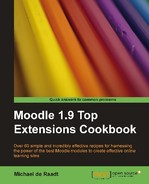In this chapter, we will cover:
- Adding video
- Creating image slideshows
- Working with books
- Visualizing programs
- Looking for a map?
- Writing mathematical formulae using drag-and-drop
Perhaps the most obvious use of a Learning Management System is to distribute content to students. This chapter looks at modules that allow content to be added to Moodle in new and exciting ways.
Note
With each module introduced it is assumed that you will know how to locate, download, and install the module. Any unusual installation details will be described for each module, but the focus from this chapter onwards is on how to set up and use the module once it is installed.
With faster connection speeds and greater storage potential, distributing course content in video form is becoming more feasible than ever before.
Video editing software often allows you to export to Flash format and may even provide you with an HTML wrapper for your video. Videos can also be hosted using services such as YouTube. You may have found a public video on a hosting site that you want to share with students.
It is possible to link to video content without adding modules, but this takes the videos out of the context of the course content. Trying to embed videos into web pages requires a knowledge of HTML and the different tags that will work with different browsers. The following activities come to the rescue; assisting you to embed videos in your course. They are described in the later sections of this chapter.
- emboodle
- Flash Video
- YouTube Video Playlist
- MultiVideo Filter
Want to share your holiday snaps with your course? How about those pictures of the Icelandic volcano erupting, or the works of a famous artist? In many courses there is a need to show an array of images to students. While it is possible to create web pages that include images, writing such pages can be tedious and later they are awkward to update. There are a couple of modules that can make displaying images much simpler, but one stands out.
- Lightbox Gallery
The Book module brings web pages closer to a real textbook. It allows teachers to present course materials in a structured fashion—with chapters, sub-chapters, and a table of contents. There are also blocks written to work with the Book module that extend books to the course page.
- Book module
- Search Books block
- Random Content block
Teaching programming is an unrelenting struggle, battling the forces of injustice where ever they may appear. Well, actually it is quite rewarding and sometimes even enjoyable. But trying to bring interactive examples into materials is difficult indeed, and there are few Moodle modules able to help in this task. But if you are teaching Java, there is one module that you might find very useful.
- Jeliot
Imagine viewing the world from the heavens, with a bird's-eye-view from country to country and into everyone's back yard. Imagine the potential educational possibilities such power could bring. Well imagine no more.
- Map module
